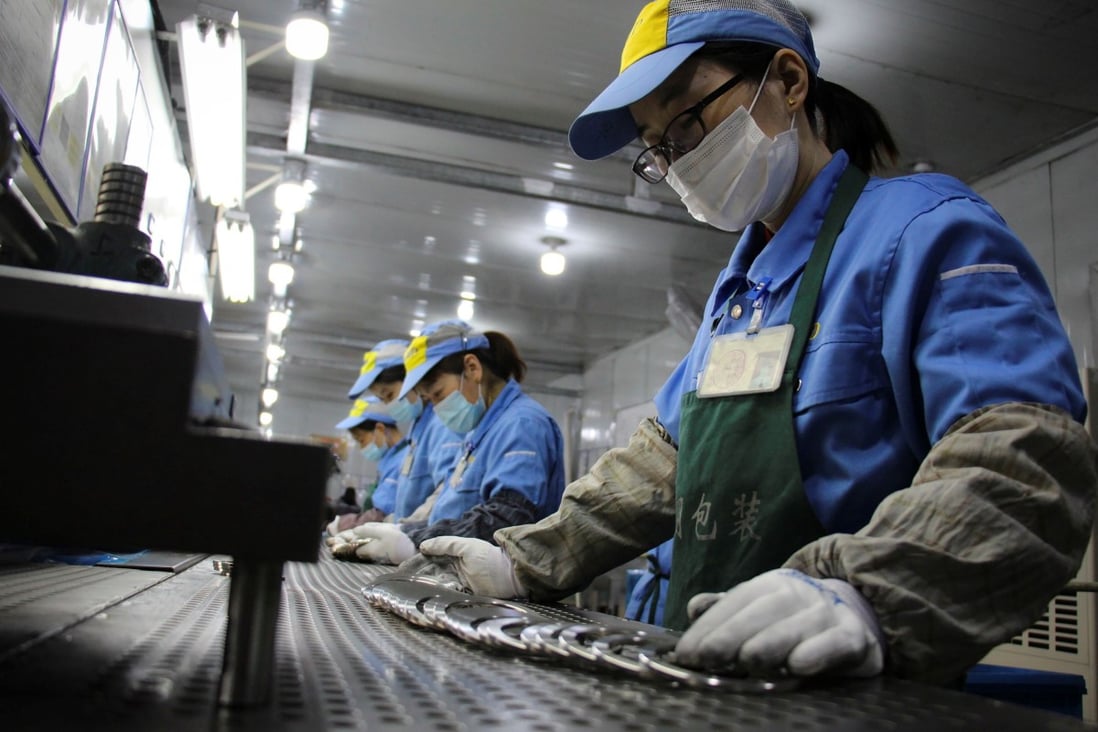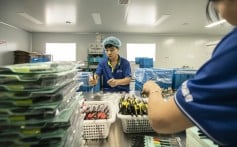Factories in China’s south and east are struggling to find enough workers to fill surging export orders thanks to strong demand in Western countries
The uptick in orders is proving a double-edged sword for many manufacturers, driving up wages and in some case forcing them to delay shipments

Chinese factory owners scrambling to find enough workers to keep pace with overseas orders. Photo: Xinhua
A sharp rebound in China’s manufacturing in recent months, spurred on by surging demand for exports in the West, has caused labour shortages in the country’s south and east, with many factory owners scrambling to keep pace with overseas orders.
Employers are offering higher wages to entice migrant workers back from their hometowns, but analysts say the shortfall in employees is likely to last well into next year.
China’s exports surged at the fastest pace in almost three years in November, the sixth consecutive month of growth, with manufacturers continuing to capitalise on coronavirus restrictions elsewhere in the world.
Exports grew by 21.1 per cent last month from a year earlier, as China continued to ship medical equipment to combat the virus and electronic goods for people stuck at home.
The export growth has underlined China’s strong recovery from the pandemic, with the
economy growing 4.9 per cent year on year in the third quarter and the official survey-based unemployment rate falling to 5.2 per cent last month, the same level as December 2019.

But amid a tight labour market, the rapid uptick in orders is proving a double-edged sword for many factory owners.
“Factories that have recently received new orders are paying a high price to recruit short-term workers,” said Lu Zhou, an operations director at a foreign-invested medical equipment maker in Taicang, a city in the eastern province of Jiangsu.
“The industrial zones in Taicang and [nearby] Suzhou are full of recruitment ads and labour agencies asking for 300 yuan for introducing a worker, and the price is still rising.”
Some factory owners have increased wages to about 22 to 24 yuan (US$3.60) per hour, Lu said, although most small and medium-sized businesses prefer to hire temporary workers due to the uncertain global economic outlook.
News that skilled workers are now earning up to 10,000 yuan (US$,1528) a month has spread like wildfire among China’s army of 290 million migrant workers, many of whom have been out of work for part of the year due to factory closures and lockdowns.
After months of living under lockdown in Hubei province, the epicentre of China’s coronavirus outbreak, Cao Jin has bounced from province to province, picking up work on the night shift at a factory in Foshan, Guangdong province, before heading west to Xinjiang province to work in construction.
Some factory owners have increased wages to about 22 to 24 yuan (US$3.60) per hour, Lu said, although most small and medium-sized businesses prefer to hire temporary workers due to the uncertain global economic outlook.
News that skilled workers are now earning up to 10,000 yuan (US$,1528) a month has spread like wildfire among China’s army of 290 million migrant workers, many of whom have been out of work for part of the year due to factory closures and lockdowns.
After months of living under lockdown in Hubei province, the epicentre of China’s coronavirus outbreak, Cao Jin has bounced from province to province, picking up work on the night shift at a factory in Foshan, Guangdong province, before heading west to Xinjiang province to work in construction.
The labour market will further tighten, and there may be a relatively strong labour shortage problem next year Liu Ligang
But the 39-year-old is now eyeing a return to one of China’s export-oriented manufacturing hubs, like Guangdong or Zhejiang, after hearing he could be earning 20 per cent more than in 2019.
“My [old] boss welcomes me to join anytime because the factory is short on labour and he estimates there are enough orders for employees to work on rotating [12-hour] shifts until next October,” said Cao, who spent years working in Guandong factories.
“In the middle of the year, the boss was worried the factory would close down. But output is now 20 per cent higher than last year.”
China’s factories get a Christmas boost from disrupted supply chains
25 Dec 2020

Liu Ligang, chief China economist at Citigroup, said the labour market will further tighten, and there may be a relatively strong problem next year.
“Many workers stayed at home because of the pandemic ... As more go back to work after the economy recovers and quarantine rules are lifted, that could help curb labor shortage,” he said.
China GDP: economy grew by 4.9 per cent in third quarter of 2020
Not even rising wages are enough to lure all migrant labourers back to work, particularly those in younger generations.
“Earning 8,000 yuan a month sounds good, but it’s actually exhausting work,” said Li Dian, who is in her 20s, from Hunan province. “It’s a lot of pressure working 12 hours per day, 6 days per week, with only half an hour for meals and no rest during the shift.”
Li worked for an electronics factory in Dongguan, a manufacturing hub in Guangdong province, before quitting in the summer and returning to her hometown, where she now earns between 3,500 yuan and 5,000 yuan a month at a local factory.
For employers, the unstable global recovery from the pandemic is still a concern.
“In October and November, there were many new orders, but in December we suddenly saw an obvious drop,” said Wang Jie, who runs a footwear factory in Dongguan.
“We have heard that the pandemic is becoming even worse [outside China] … we are actually very scared.
“We could not survive another round of cancellations and postponements of orders.”
In late February, Wang took orders for more than 90,000 pairs of shoes, but 80,000 were cancelled in late March, when the outbreak began to gather pace around the world and many countries started to seal their borders.
“Many payments have also been delayed, and I still haven’t got the payments I should have in summer,” he said.
Shanghai General Sports, a motorcycle and bicycle manufacturer, has had a good year as bicycle sales boomed this year in the United States, its primary export market.
But general manager Ge Lei said a shortage of workers had forced it to delay delivery for most of the year and orders are already lined up until June 2020.
At the same time, an appreciating Chinese yuan and little room for price negotiation with foreign clients has not made business particularly profitable.
The yuan has steadily appreciated against the US dollar this year and many economists believe it could strengthen further.
“Our payment period is normally three months. It’s OK when we start delivering goods. But when we get payments, there is a foreign exchange loss,” Ge said.
No comments:
Post a Comment